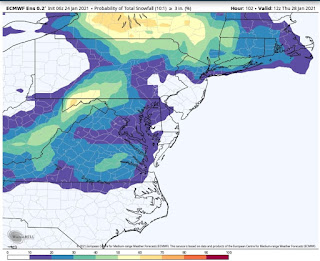Well, we made it to Sunday and we still have a snow threat middle part of the week. With that, the threat changed in how it is set up.
The first view on the models had well into cold and very dry air and a storm even cutting west of our region, snow would break out and likely maintain as snow as the low jumped towards the coast.
As we've gotten closer, the storm seems to be about 12 hours faster, starting overnight Wednesday and the cold air is not quite as strong changing the storm to a dynamically driven event. (And that's if the event takes place) This means we have to rely on the a strong upper air low to interact with the surface low and cool the atmosphere by both pulling in the cold air that is slowing sinking towards our region AND the strong lift (rising air cools, sinking air warms) from the deepening low. This is because we don't have cold air in place, but arriving and being created as the storm unfolds.
We have 2 basic storm evolutions displayed:
1. Precipitation from the west comes in over head as the upper air and surface low interact. Storm gets close enough and we got heavy rain to heave snow. Data showed 4 to 8 inch snow totals in this event with a sharp south cut off. Remember, 4 days out thinks like to drift north so this could happen but we get next to nothing.
Another evolution problem is that some models showed the precipitation moving in from the west and as the transition happens the precipitation collapses quickly towards the low. Hence, we get the higher end solution but it infers risks that little to no snow could fall in that region. (That zone was east of the Blue Ridge)
Variations of this are show on the GFS and to an extent the Canadian Model.
 |
| European model risk of 3 inches in percentages. |
 |
| American Model risk of 3 inches. |
2. Very little precipitation over head initially but the upper air low initiates a round of snow more along the lines of 1-3 inches. These tend to be more challenging to forecast because upper air snow "form during the event"-- so some people get it and some don't. The models showed a NW to SE band of snow that coved much of our region.
Variations of this have been shown on the Euro and UK met model.
Snow Potential.
30% chance your specific location gets no measurable snow. (Trace amounts fall here)
40% chance your location sees a coating to 2 inches.
20% chance your location sees 2-4 inches
10% chance your location sees over 4 inches.
Here are my current views for risks
Very broad brushed at this time, but this is by far our best shot region wide for some snow. Each region has reasons why they could miss. Southside could be too far south, NRV and I81 region could be too far west. Lynchburg could literally be to east, too west, to north and too south. (It feels that way after almost 2 years with no measurable snow)
No comments:
Post a Comment